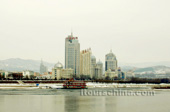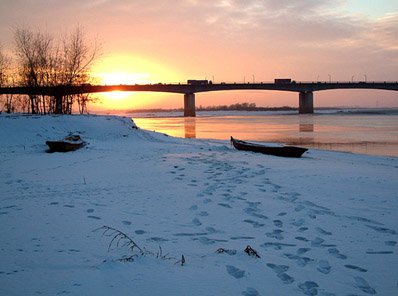
Songhua River Guide
-Travel to Songhua River The Songhua River is a river in Northeast China, and is the largest tributary of the Heilong River, flowing about 1,927 km from Changbai Mountains through the Heilongjiang and Jilin provinces. The river drains 212,000 square miles of land. It joins the Amur at the town of Dongjiang. The river has a dam at Fengman, which is used for hydroelectricity production. It forms a lake that stretches 62 km upstream. Below the dam, the river flows northwest until its largest tributary, the Nen River, joins it near Da'an. The Nen River drains the northern Manchurian Plain.
The Songhua River is a river in Northeast China, and is the largest tributary of the Heilong River, flowing about 1,927 km from Changbai Mountains through the Heilongjiang and Jilin provinces. The river drains 212,000 square miles of land. It joins the Amur at the town of Dongjiang. The river has a dam at Fengman, which is used for hydroelectricity production. It forms a lake that stretches 62 km upstream. Below the dam, the river flows northwest until its largest tributary, the Nen River, joins it near Da'an. The Nen River drains the northern Manchurian Plain.
 The river travels east until it joins the Hulan River near Harbin. Then it passes between the northern end of the eastern Manchurian mountain system and the Lesser Khingan Range. The river then flows into the Amur River valley. The river freezes from late November until March. It has its highest flows when the mountain snow melts during the spring thaw.Smaller craft can navigate the Songhua up to Jilin and the Nen River up to Qiqihar. Along the Songhua River, in various different points and in different cities, there are many activities that people love to take part in, throughout the entire year.
The river travels east until it joins the Hulan River near Harbin. Then it passes between the northern end of the eastern Manchurian mountain system and the Lesser Khingan Range. The river then flows into the Amur River valley. The river freezes from late November until March. It has its highest flows when the mountain snow melts during the spring thaw.Smaller craft can navigate the Songhua up to Jilin and the Nen River up to Qiqihar. Along the Songhua River, in various different points and in different cities, there are many activities that people love to take part in, throughout the entire year.
The banks of Songhua River and the island found in the middle are ideal natural tourist attractions and sun bathing areas. The lofty Commemoration Tower of Victory over Flood, the flying Songhua River Road Bridge, the exquisite River Club, the magnificent circular Labor's Stadium, along with skillful art carvings in Stalin Park and constructions with childhood color all make the Songhua River look much more supple and graceful and appealing.
More Attractions in Harbin
Your Question & Quick Answer*We welcome and appreciate your questions & reviews
Booking Procedures | Terms & Conditions | Payment Methods | Links | Site Map | About Us | Contact Us | Travel Agent
Copyright 2008, All rights reserved.. itourbeijing.com professional china travel guide and china travel service
TEL: 86-10-85711972 (Universal) 1-888-288-9328 (North America) E-mail: contact@itourbeijng.com
Tours Index | China Tours | Beijing Tours | Xi'an Tours | Shanghai Tours | Guilin Tours | Tibet Tours
China Travel | Beijing Travel | Shanghai Travel | Xi'an Travel | Guilin Travel |Beijing Map
China Golf | Beijing Golf | Shanghai Golf | Xiamen Golf | The Great Wall Travel | Yangtze Cruise | Travel Picture



